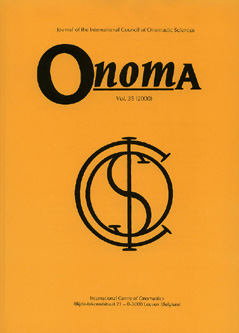 previous article in this issue previous article in this issue | next article in this issue  |

Preview first page |
Document Details : Title: Who Sets the Norms of Naming? Subtitle: Traditional Naming Practices in Agrarian Finland and Onomastic Legislation Author(s): KOTILAINEN, Sofia Journal: Onoma Volume: 47 Date: 2012 Pages: 137-161 DOI: 10.2143/ONO.47.0.3085143 Abstract : In this article I study how and why a naming culture which had long been characterised by popular practices changed as a result of onomastic legislation. National name laws affecting the majority of Finns were enacted quite late after Finland became independent, only in the 1920s and 1940s. Earlier, when Finland had belonged first to Sweden and then to Russia, the agrarian population had been able to choose the forenames of their children quite freely as long as they did not contravene the norms of Christianity and the Evangelical Lutheran Church. The church legislation did not stipulate in detail how the forenames and surnames of babies should be chosen or what surname a married woman should use. In practice, the propriety of forename choices was controlled by the local clergy. For the name-givers, the name they chose for their child was not insignificant. The name choices of rural people were mainly regulated by unofficial communal norms and family traditions. For them, personal names constituted immaterial social capital, which the naming legislation of the early twentieth century affected only slowly. Dans cet article, j’étudie comment et pourquoi une culture de nomination, longuement caractérisée par des pratiques populaires, a pu évoluer à cause de la législation du nom. Ce n’est que dans les années 1920 et 1940 qu’ont été adoptées au niveau national des lois qui affectaient la majorité des Finlandais, donc relativement tardivement après l’accession du pays à l’indépendance en 1917. Plus tôt, quand le pays appartenait à la Suède puis à la Russie, la population rurale choisissait librement les prénoms des enfants dans le cadre des normes fixées par les églises catholique et luthérienne. Les normes ecclésiales ne précisaient pas en détail comment devaient être choisis les prénoms et les noms de famille des enfants, ou le nom de famille d’usage des femmes mariées. En fait, la convenance du choix des prénoms était contrôlée par le clergé local. Pour les parents, le nom choisi n’était pas insignifiant: le choix du nom obéissait à des normes communautaires non officielles, ainsi qu’à des traditions familiales. Pour eux, les noms de personne constituaient un patrimoine social immatériel que la législation du nom n’a pu affecter que lentement. In diesem Artikel wird untersucht, wie und warum sich eine Namenkultur, die eine lange Zeit von einem volkstümlichen Usus bestimmt gewesen war, infolge der Namengesetzgebung verändern konnte. Staatliche Namensgesetze, die die Mehrheit der Finnen betrafen, wurden ziemlich spät nach der Unabhängigkeit Finnlands, und zwar erst in den 1920er und 1940er Jahren, beschlossen. Früher, als Finnland zunächst zu Schweden und dann zu Russland gehörte, konnte die ländliche Bevölkerung den Vornamen ihrer Kinder ziemlich frei auswählen, solange er nicht den Normen des Christentums bzw. der evangelisch-lutherischen Kirche widersprach. Die Kirchengesetze hatten allerdings nicht im Einzelnen festgelegt, wie der Vor- und Nachname von Kindern auszuwählen oder welche Familiennamen von verheirateten Frauen zu führen waren. In der Praxis wurde die Angemessenheit der Vornamenwahl vielmehr von der örtlichen Geistlichkeit überwacht. Für die Namengeber war nämlich der Name ihres Kindes nicht unwichtig. Die Namenwahl der ländlichen Bevölkerung wurde hauptsächlich von inoffiziellen kommunalen Normen und Familientraditionen gesteuert. Für diese waren Personennamen immateriell sozial Kapital, mit der sich die Namengesetzgebung des frühen 20. Jahrhunderts nur sehr zurückhaltend befasste. |
|


